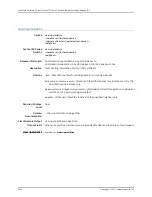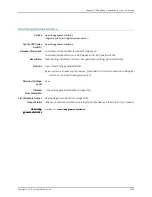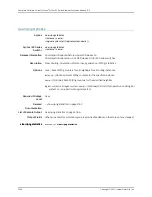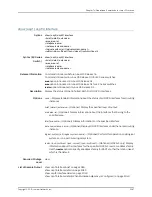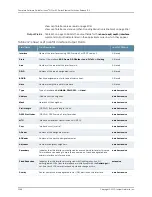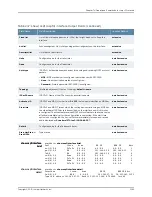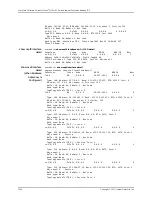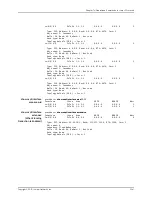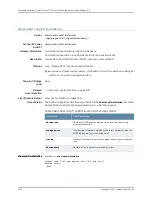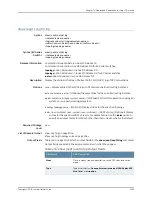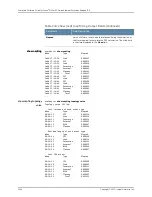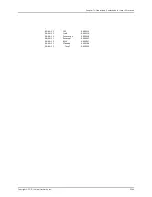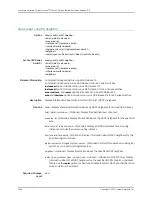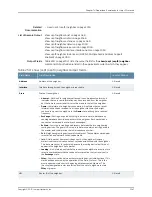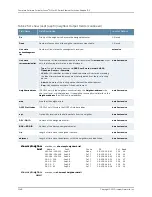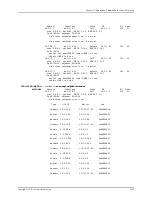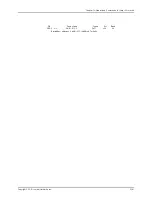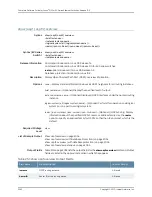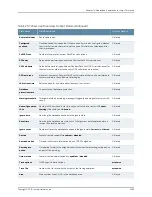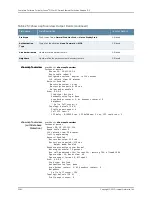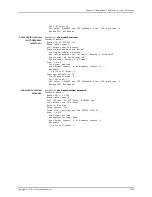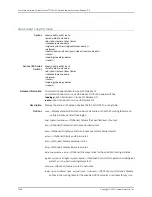
Related
Documentation
clear (ospf | ospf3) neighbor on page 2016
•
List of Sample Output
show ospf neighbor brief on page 2048
show ospf neighbor detail on page 2048
show ospf neighbor extensive on page 2049
show ospf3 neighbor detail on page 2050
show ospf neighbor area area-id on page 2050
show ospf neighbor interface interface-name on page 2050
show ospf3 neighbor instance all (OSPFv3 Multiple Family Address Support
Enabled) on page 2050
Output Fields
Table 250 on page 2047 lists the output fields for the
show (ospf | ospf3) neighbor
command. Output fields are listed in the approximate order in which they appear.
Table 250: show (ospf | ospf3) neighbor Output Fields
Level of Output
Field Description
Field Name
All levels
Address of the neighbor.
Address
All levels
Interface through which the neighbor is reachable.
Interface
All levels
State of the neighbor:
•
Attempt
—Valid only for neighbors attached to nonbroadcast networks. It
indicates that no recent information has been received from the neighbor,
but that a more concerted effort must be made to contact the neighbor.
•
Down
—Initial state of a neighbor conversation. It indicates that no recent
information has been received from the neighbor. Hello packets might
continue to be sent to neighbors in the
Down
state, although at a reduced
frequency.
•
Exchange
—Routing device is describing its entire link-state database by
sending database description packets to the neighbor. Each packet has a
sequence number and is explicitly acknowledged.
•
ExStart
—First step in creating an adjacency between the two neighboring
routing devices. The goal of this step is to determine which routing device is
the master, and to determine the initial sequence number.
•
Full
—Neighboring routing devices are fully adjacent. These adjacencies appear
in router link and network link advertisements.
•
Init
—A Hello packet has recently been sent by the neighbor. However,
bidirectional communication has not yet been established with the neighbor.
This state may occur, for example, because the routing device itself did not
appear in the neighbor's hello packet.
•
Loading
—Link-state request packets are sent to the neighbor to acquire more
recent advertisements that have been discovered (but not yet received) in
the
Exchange
state.
•
2Way
—Communication between the two routing devices is bidirectional. This
state has been ensured by the operation of the Hello Protocol. This is the
most advanced state short of beginning adjacency establishment. The
(backup) designated router is selected from the set of neighbors in state
2Way
or greater.
State
All levels
Router ID of the neighbor.
ID
2047
Copyright © 2010, Juniper Networks, Inc.
Chapter 74: Operational Commands for Layer 3 Protocols
Summary of Contents for JUNOS OS 10.3 - SOFTWARE
Page 325: ...CHAPTER 17 Operational Mode Commands for System Setup 229 Copyright 2010 Juniper Networks Inc ...
Page 1323: ...CHAPTER 56 Operational Mode Commands for Interfaces 1227 Copyright 2010 Juniper Networks Inc ...
Page 2841: ...CHAPTER 86 Operational Commands for 802 1X 2745 Copyright 2010 Juniper Networks Inc ...
Page 3367: ...CHAPTER 113 Operational Mode Commands for CoS 3271 Copyright 2010 Juniper Networks Inc ...
Page 3435: ...CHAPTER 120 Operational Mode Commands for PoE 3339 Copyright 2010 Juniper Networks Inc ...
Page 3529: ...CHAPTER 126 Operational Mode Commands for MPLS 3433 Copyright 2010 Juniper Networks Inc ...


